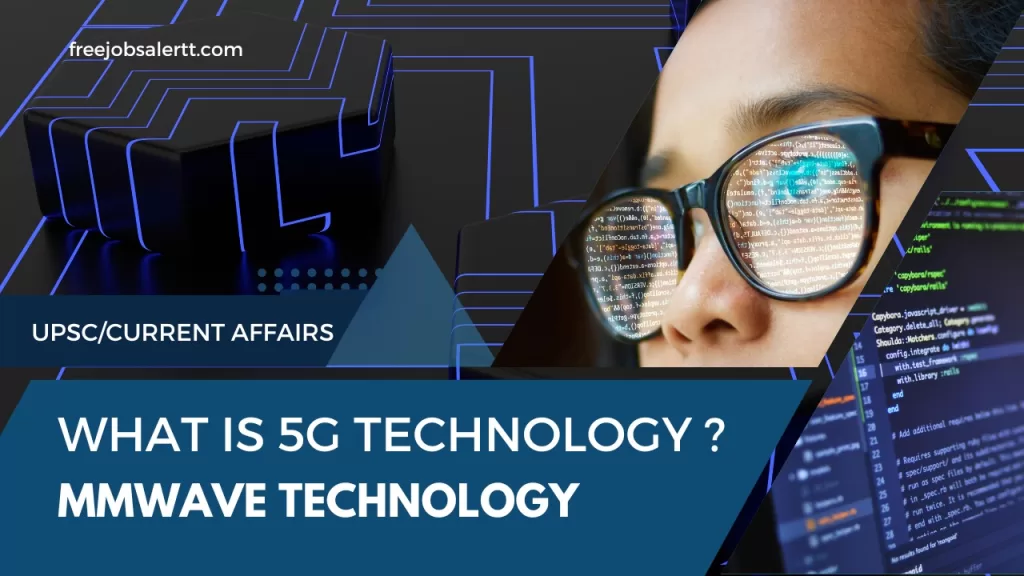So what is 5G technology? Is 5G technology helpful for us? What is 5g technology UPSC Current Affairs? So here We know about all answers to your Questions that are in your mind if there is any question in your mind that I have not answered so please comment I will definitely give you a perfect answer. So without wasting any time let’s discuss 5G Technology.

What is 5g technology? Definition
As a network communication technology, 5G is in its fifth generation. In late 2019, mobile phone operators began deploying 5G in select cities, and more will follow in 2020. It is theoretically capable of going up to 20 Gbps for downlinks and 10 Gbps for uplinks. This is 100 times faster than 4G LTE, and 10 times faster than 4G LTE. As a result, real-world speeds are expected to be 100 Mbps download and 50 Mbps upload in the future. When a device connects to the network under ideal conditions, latency is typically four milliseconds, but remote surgery applications can have latency as low as one millisecond.
The Advantages of 5G technology include:
- Transmissions with greater speed:
- Transmission speeds can reach 15 or 20 GBPS (Gigabytes Per Second).
- As a comparison, 4G offers maximum download speeds of around 100 MBPS.
- Reduced latency:
- It is the amount of time that has passed since we gave an order on our device until the action was performed.
- As a result of 5G, remote actions can be performed in real-time with ten times less latency than in 4G.
- An increased number of devices are connected:
- As all devices are connected to the internet, they will be able to exchange information in real-time. This will make the Internet of Things (IoT) a success.
- A network of physical objects called “things” connect to other devices and systems over the Internet by embedding sensors, software, and other technologies.
- Several hundred connected devices will be able to transmit and receive information in real-time in a typical home.
- As all devices are connected to the internet, they will be able to exchange information in real-time. This will make the Internet of Things (IoT) a success.
Disadvantages of 5G technology include:
However, 5G technology has the following limitations due to some security reasons and a lack of technological advancement in most geographic regions, even though it has been conceptualized to solve all radio signal problems and hardships of the mobile world.
- Currently, technology is under development, and research is being conducted to determine its viability.
- It seems impossible (in the future, it might be) to achieve the speed this technology claims due to incompetent technological support.
- In order to implement 5G, many of the older devices need to be replaced, which can be an expensive process.
- Infrastructural development is costly.
- The issue of privacy and security has yet to be resolved.
What is 5G mm-wave technology?
As 5G New Radio (5G NR or simply 5G) standards emerge for mobile cellular networks, this technology brief examines how they may revolutionize wireless communication in a completely new way. Additionally, 5G services extend to frequencies beyond 6GHz, including bands used for 4G LTE networks, as well as to much higher frequencies that were previously unconsidered for mobile communications. Millimeter wave (mmWave) frequency bands, which cover a range of 24 GHz to 100 GHz, present 5G networks with new challenges and benefits.
This technology brief discusses the emergence of 5G wireless mmWave. As part of the mmWave technology revolution, mmWave spectrum is available, bandwidths are supported, and antenna technologies are discussed to ensure multiple gigabit data rates are delivered to end users. Lastly, some deployment scenarios are discussed where 5G mmWave networks will start making an impact on daily wireless communication.
What is the benefit of 5G mm-wave technology?
The benefits of 5G mmWave
The advantages of 5G mmWaves are listed below. These advantages make this technology one of the best candidates for future wireless communications in mobile devices.
- Allows more subscribers to be accommodated with more bandwidth.
- Microphones with a millimeter bandwidth are suitable for use with this device.
- Due to the feasibility of the primary scatter path, coverage is not limited to line-of-sight.
- In order for 5G networks to function efficiently, different types of mmWave frequency loss are considered using the channel probing feature. By measuring or estimating channel characteristics, you can design, develop, and deploy a 5G network that meets the required quality standards.
- Due to the physical size of their antennas, many antennas are packaged in smaller sizes.
- Mobile access over 200-300 meters is supported by the 5G mmWave network, with a multi-gigabit backhaul of up to 400 meters.
There are some facts and fiction you need to know about 5G mmWave
- In addition to not being able to penetrate walls, the transition from indoors to outdoors is not very effective with mmWave. In contrast, large-scale MIMO and beamforming do not require a line of sight in order to be successful. To ensure a proper signal, millimeter-wave signals may bounce around the building instead of penetrating deep into it.
- It’s impossible to connect to 5G during rain – Millimeter-wave signal strength drops when it rains, first at a slower speed, and then problems with connectivity can occur. The severity depends on how hard it rains and other factors, such as how far it is from the cell tower.
UPSSSC Uttar Pradesh Forest Guard Van Daroga Recruitment 2022

India’s 5G technology
According to India’s National Digital Communications Policy 2018, 5G technology is critical for the nation’s future.
Cloud Computing, IoT, Big Data, Artificial Intelligence, and Data Analytics are all impacted by 5G, which enables the convergence of these technologies.
There are, however, a number of key obstacles to the deployment of 5G in India, including:
- Currently, the nation has only 30% fiber connectivity on telecom towers. This number needs to be doubled to support the rollout of 5G.
- It creates a high dependence on hardware made in India due to the ban on foreign telecom OEMs.
- A more efficient setup is required to lower overall pricing for 5G spectrum, which is more expensive than the global average.
- Different band spectrums are needed to bridge the gap between rural and urban networks.
In India, 5G networks have the potential to transform the way we live and think. This is a great chance for the telecom sector to grow and ensure global competitiveness. In order for 5G to be widely and equally deployed, India must ensure that infrastructure and spectrum sales are overcome. This will enable the country to take advantage of 5G as quickly as possible.
What is 5G Technology UPSC Current Affairs
Mobile network generation before 5G,
Besides these four networks, which have been utilized extensively for different purposes in the past and present, 5G will transform the whole digital world; let’s take a look at some of the previous networks.
- Voice calls were only supported on 1G, which was introduced in 1980 on radio signals
- In 1990, 2G was introduced with voice and data support over radio signals
- With 3G, you can make calls, view videos, and hold conferences.
- A 4G network was launched in 2010, with a peak speed of 100 Mbps to 1 Gbps for 3D virtual reality. This is the network on which we rely.
Bands of the 5G spectrum
The 5G network uses three different spectrum bands.
- The low-band spectrum offers excellent coverage area and wall penetration
- In addition to providing higher speeds and lower latency, the mid-band spectrum is also more widely available, but there is a lower level of building penetration than the low-band spectrum.
- The third option is to use a high-band spectrum, although this does not offer the highest speed and is limited in its coverage area and penetration into buildings.
| Generation | Theoretical Speed | Technology | Features |
| 2G | 9.6/14.4Kbps | TDMA, CDMA | Data transfers and calls were made using 2G-enabled phones. |
| 3G | 3.1Mbps | CDMA 2000 (1XRTT, EVDO, UMST, EDGE) | Video conferencing and streaming were made possible by 3G technology and enabled fast data browsing on mobile devices. |
| 3.5G | 14.4Mbps | HSPA | Transferring data has never been faster. |
| 4G | 100-300Mbps | WiMax LTE | High-definition streaming was made possible by extremely fast download speeds. |
| 5G | 10-30Gbps | Developing | Improved reliability, ultra-fast internet, and low latency. |
- Several phases will be involved in launching 5G services in India.
- At first, it will be available in 13 cities in India, including Delhi, Bengaluru, Mumbai, Chennai, Ahmedabad, Chandigarh, Gandhinagar, Hyderabad, Kolkata, Lucknow, Pune, Jamnagar, and Gurugram.
- The 5G service is expected to be available by Diwali in major metropolises such as Chennai, Mumbai, Delhi, and Kolkata.
- Next-generation networks will be available in the rest of the country by December 2023.
In 5G Technology, there is a bonus for you that I will show you how you can earn money by Reddit its works 100% click here to know that Make Money with Reddit 100%
How was 5G technology introduced to India?
Shri Narendra Modi
What are the advantages of 5G over 4G?
The reason 5G networks are faster is that they use higher-frequency radio bands to transmit signals. These bands previously had little commercial use, which makes them more efficient at carrying data.
What is the processor used in 5G?
The Qualcomm® SnapdragonTM X65 is Qualcomm Technologies’ flagship 5G solution. It is designed to achieve peak data rates of up to 10 Gbps in the downlink.
When did 5G first launch?
Airtel launches 5G services for the first time: Cities and pricing details. Sunil Bharti Mittal, chairman of Bharti Airtel, said at the sixth edition of India Mobile Congress (IMC 2022) that the company’s 5G service will be available in select cities beginning Saturday (October 1) .
What is the first place where 5G was launched?
In today’s launch of 5G services at Pragati Maidan in New Delhi, the Prime Minister, Shri Narendra Modi, ushered in a new technological era. Furthermore, the Prime Minister attended the IMC Exhibition as well as the sixth edition of the India Mobile Congress.
Can you tell me what the maximum speed of 5G is?
Ookla, a US-based firm that tests mobile and network networks, has found that 5G download speeds can reach 500Mbps on Indian test networks, with speeds topping 800Mbps.
When did the first 5G network launch in India?
Pragati Maidan, New Delhi, was the site of the first phase of 5G service launched by Prime Minister Narendra Modi on Saturday.
In what frequency does 5G operate?
In low-band 5G, the frequency range is similar to that of 4G cellphones, 600–900 MHz, giving download speeds about twice as fast as 4G, between 30 and 250 megabits per second (Mbit/s).
Why is 5G beneficial?
5G, IoT, and edge computing offer high speed, low latency, and massive capacity, allowing technology to connect to mobile networks at a greater rate than ever before, enabling the Internet of Things on a grand scale.
